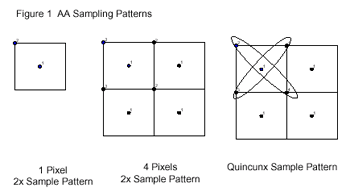NVIDIA's GeForce3: "NV20" Revealed
by Anand Lal Shimpi on February 27, 2001 9:16 AM EST- Posted in
- GPUs
The truth is heard: FSAA is important
Quite possibly the biggest struggle we've ever seen in the 3D graphics market was 3dfx's attempt to convince the industry that their FSAA was of more value than the raw speed NVIDIA could promise. Unfortunately their message wasn't heard clear enough and combined with an extremely late Voodoo5 release, it wasn't enough to do battle with NVIDIA's stronghold.
Now that NVIDIA has the core assets of 3dfx, and along with that a total of 110 engineers and architects from the former 3dfx, NVIDIA is focusing a little more on bringing FSAA to the masses. However the methods employed by 3dfx and NVIDIA with the supersampling FSAA that was pushed so much last year are simply not efficient enough. Supersampling consisted of the graphics accelerator rendering more pixels than were actually going to be displayed, and filtering them down to the point where a lot of the aliasing artifacts were removed. Unfortunately this is very inefficient since you had 2x and 4x reductions in peak fill rate with these supersampling FSAA methods.
With the GeForce3, NVIDIA introduced their High Resolution Antialiasing or HRAA. NVIDIA's HRAA is a true hardware FSAA solution that relies on a multisampling algorithm to achieve the same reduction of aliasing that we're used to from conventional supersampling methods but without the reduction in fill rate. The reduction in fill rate is avoided by making sure that the multiple samples being taken when AA is enabled are all actually using the same texture data. So you get the same memory bandwidth hit, but the pixels are all using the same texture data and thus don't have to be re-rendered.
NVIDIA is combining this with a new AA algorithm using a Quincunx pattern to obtain the points to blend together to actually get rid of the aliasing artifacts. Before you jump on NVIDIA's marketing team for the name Quincunx you have to understand that it's actually the name of the five-pointed pattern that NVIDIA uses as the basis for their HRAA algorithm.

The combination of the GeForce3's hardware based multisampling HRAA and its use of Quincunx patterns results in quality identical to what you would expect from a conventional 4-sample FSAA solution yet with the performance hit of what you would expect from a 2-sample FSAA solution.
The number NVIDIA is quoting with this is running Quake III Arena at 1024 x 768 x 32 with Quincunx AA enabled and getting 74 fps. This is obviously twice as fast as the GeForce2 Ultra with its 4X FSAA enabled under the same situation.










0 Comments
View All Comments